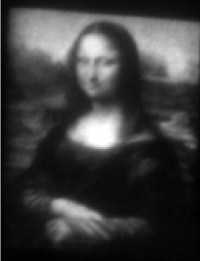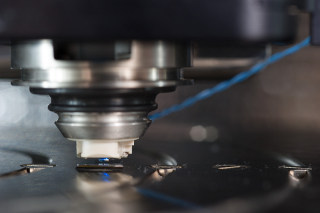 |
| August 27, 2013 | Volume 09 Issue 32 |
Designfax weekly eMagazine
Archives
Partners
Manufacturing Center
Product Spotlight
Modern Applications News
Metalworking Ideas For
Today's Job Shops
Tooling and Production
Strategies for large
metalworking plants
Nanomanufacturing technique creates mini Mona Lisa 30 microns wide
The world's most famous painting has now been created on the world's smallest canvas. Researchers at the Georgia Institute of Technology have "painted" the Mona Lisa on a substrate surface approximately 30 microns in width -- or one-third the width of a human hair. The team's creation, the "Mini Lisa," demonstrates a technique that could potentially be used to achieve nanomanufacturing of devices because the team was able to vary the surface concentration of molecules on such short-length scales.

Georgia Tech researchers have created the "Mini Lisa" on a substrate surface approximately 30 microns in width. [Image: Georgia Institute of Technology.]
The image was created with an atomic force microscope and a process called ThermoChemical NanoLithography (TCNL). Going pixel by pixel, the Georgia Tech team positioned a heated cantilever at the substrate surface to create a series of confined nanoscale chemical reactions. By varying only the heat at each location, Ph.D. candidate Keith Carroll controlled the number of new molecules that were created. The greater the heat, the greater the local concentration. More heat produced the lighter shades of gray, as seen on the Mini Lisa's forehead and hands. Less heat produced the darker shades in her dress and hair seen when the molecular canvas is visualized using fluorescent dye. Each pixel is spaced by 125 nanometers.
"By tuning the temperature, our team manipulated chemical reactions to yield variations in the molecular concentrations on the nanoscale," says Jennifer Curtis, an associate professor in the School of Physics and the study's lead author.
"The spatial confinement of these reactions provides the precision required to generate complex chemical images like the Mini Lisa."
Production of chemical concentration gradients and variations on the sub-micrometer scale are difficult to achieve with other techniques, despite a wide range of applications the process could allow. The Georgia Tech TCNL research collaboration, which includes Associate Professor Elisa Riedo and Regents Professor Seth Marder, produced chemical gradients of amine groups, but expects that the process could be extended for use with other materials.

Atomic force microscope (AFM) modified with a thermal cantilever. The AFM scanner allows for precise positioning on the nanoscale while the thermal cantilever induces local nanoscale chemical reactions. [Image: Georgia Institute of Technology.]
"We envision TCNL will be capable of patterning gradients of other physical or chemical properties, such as conductivity of graphene," Curtis says. "This technique should enable a wide range of previously inaccessible experiments and applications in fields as diverse as nanoelectronics, optoelectronics, and bioengineering."
Another advantage, according to Curtis, is that atomic force microscopes are fairly common and the thermal control is relatively straightforward, making the approach accessible to both academic and industrial laboratories. To facilitate their vision of nano-manufacturing devices with TCNL, the Georgia Tech team has recently integrated nanoarrays of five thermal cantilevers to accelerate the pace of production. Because the technique provides high spatial resolutions at a speed faster than other existing methods, even with a single cantilever, Curtis is hopeful that TCNL will provide the option of nanoscale printing integrated with the fabrication of large quantities of surfaces or everyday materials whose dimensions are more than 1 billion times larger than the TCNL features themselves.
The paper, "Fabricating Nanoscale Chemical Gradients with ThermoChemical NanoLithography," is published online by the journal Langmuir.
This research was funded by the National Science Foundation.
Source: Georgia Tech
Published August 2013
Rate this article
View our terms of use and privacy policy
